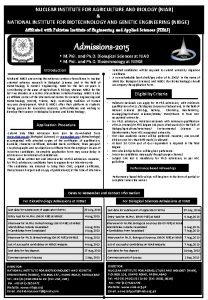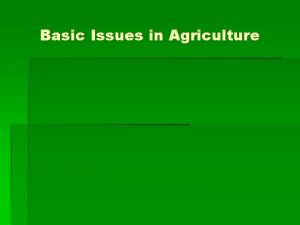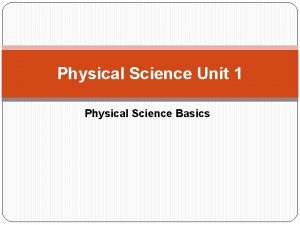Physical Science Applications in Agriculture Unit Physical Science























- Slides: 23

Physical Science Applications in Agriculture Unit Physical Science Systems

Problem Area Agricultural Mechanics and Machine Systems

Fasteners Lesson

Which fastener would you use to join wood to wood? • Which fastener would you use to join metal to metal? • How does the size of the material affect the type of fastener used? • How does use/function of the item affect the type of fastener used?

Learning Objectives 1. 2. 3. Explain how nails work. Explain how screws work. Identify the two types of loads on fasteners.

Terms • • • Helix angle Lateral load Pitch Rectilinear Wedge Withdrawal load xfscrews. en. alibaba. com/. . . /showimg. html

How do nails work? • Nails are applications of an inclined plane in the form of a wedge. • A wedge is similar to an inclined plane with two important differences. 1. A wedge is moveable. 2. The effort force for an inclined plane moves parallel to the slope but effort force for a wedge is applied parallel to the long axis of the wedge.

How do nails work? • As nails are driven into materials, the wedge converts the downward force of nail outward www. norwichfreeacademy. com/

How do nails work? 1. Nails are held in place by friction and the resistive force of the woodworking-online. com

How do nails work? 2. Longer and larger diameter nails can be expected to have more holding power because of the increased friction and wood grain forces. www. habitat. pl

How do nails work? 3. A nail too large, however, will split the wood because the nail is stronger than the wood resistive forces. woodworking-online. com/

How do nails work? 4. Nails with spiral shanks have more holding power because of increased friction and a greater wedging effect. www. global-fasteners. com/

How do screws work? • A screw is the combined application of an inclined plane, a wedge, and a wheel and axle.

How do screws work? • The screw threads contain two small scale applications of an inclined plane. 1. The helix angle or slant of the threads on a screw is an inclined plane. 2. The threads are shaped as a wedge. 3. Screw threads convert rotary motion to rectilinear or straight line motion.

How do screws work? • The distance between two successive threads on a screw is the pitch. 1. The pitch of screw threads creates a magnified force that helps to drive the screw into the wood. 2. The distance traveled by the screw is determined by screw pitch and the number of times the screw is turned.

Helix angle of a screw corresponds to the angle of an inclined plane 1. This angle should be as small as possible. 2. The greater the helix angle, the greater the force exerted by the screw as it is turned. • 3. Finer threads make a shallower cut in the wood and exert a smaller force as they are turned into the material. – This is why finer threads strip more easily than coarser threads.

What are the two types of loads on fasteners? 1. 2. Lateral loading pulls at a right angle to the fastener and produces a lateral pressure against the wood fibers. Withdrawal loading pulls parallel to the fastener and tends to pull it from the wood.

Lateral Loading • The holding capacity of wood fasteners depends upon: a. Density, specific gravity, and seasoning of the wood. b. The type and size of the fastener. c. The penetration of the fastener. d. The position of the fastener with respect to the wood grain.

Lateral Loading 2. Clinching a nail may increase lateral resistance by fifty percent of more. 3. Lateral resistance is greater than withdrawal resistance. smithfrancistools. com

Withdrawal loading Nails provide stronger wood joints if they are driven perpendicular to the wood grain rather that parallel to the wood fibers.

Withdrawal loading • Tests have shown fifty to seventy-five percent less withdrawal resistance when nails are driven parallel to wood fibers. • Nails driven into the end of a wood piece will have less withdrawal resistance than those driven into the face or edge of a board.

Withdrawal loading • Higher density woods provide stronger joints and better withdrawal resistances. • Coatings, rough surface texture, and grooved shanks also increase the withdrawal resistance

Review/Summary • How do nails work? • How do screws work? • What are the two types of loads on fasteners?
 Physical factors influencing agriculture
Physical factors influencing agriculture Physical factors influencing agriculture
Physical factors influencing agriculture The history of farming
The history of farming Unit 6 review questions
Unit 6 review questions Six branches of science
Six branches of science Natural and physical science
Natural and physical science What's your favourite subject
What's your favourite subject Physical devices of a computer
Physical devices of a computer Elements of a computer
Elements of a computer Synchrotron
Synchrotron Novel data science applications
Novel data science applications Vital villages thriving towns introduction
Vital villages thriving towns introduction Circular agriculture netherlands
Circular agriculture netherlands Hunters and gatherers
Hunters and gatherers Heisa and leisa
Heisa and leisa Slash and burn agriculture antonym
Slash and burn agriculture antonym Safety colors in agriculture
Safety colors in agriculture Agriculture
Agriculture Crown plants examples
Crown plants examples Weed science definition
Weed science definition Agriculture internship in germany
Agriculture internship in germany Ict tools used in agriculture
Ict tools used in agriculture Nuclear institute for agriculture and biology
Nuclear institute for agriculture and biology 10 importance of agriculture
10 importance of agriculture












































